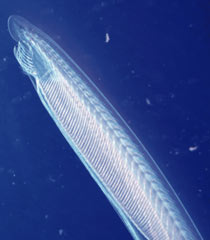 Amphioxus possesses clear segmented, myomeric musculature that is an important point of comparison to vertebrate muscles for understanding the origins and evolution of vertebrate somatic musculature. The whole genome duplications that occurred at the origins of vertebrates (the 2R hypothesis) and then again early in teleost evolution (the 3R hypothesis) had important impacts on the composition of all sorts of gene networks, including those controlling muscle development and function. Amphioxus provides an excellent outgroup comparison to the vertebrates, such as the conventional models in developmental biology (e.g. mouse, chick, zebrafish) as well as important sources of food (e.g. salmon, carp), which will enable the impacts of these large-scale duplication events on muscle gene networks to be deduced.
Amphioxus possesses clear segmented, myomeric musculature that is an important point of comparison to vertebrate muscles for understanding the origins and evolution of vertebrate somatic musculature. The whole genome duplications that occurred at the origins of vertebrates (the 2R hypothesis) and then again early in teleost evolution (the 3R hypothesis) had important impacts on the composition of all sorts of gene networks, including those controlling muscle development and function. Amphioxus provides an excellent outgroup comparison to the vertebrates, such as the conventional models in developmental biology (e.g. mouse, chick, zebrafish) as well as important sources of food (e.g. salmon, carp), which will enable the impacts of these large-scale duplication events on muscle gene networks to be deduced.
- Aase-Remedios, M.E. & Ferrier, D.E.K. Improved understanding of the role of gene and genome duplications in chordate evolution with new genome and transcriptome sequences. Frontiers in Ecology & Evolution (2021) 9:703163.
- Aase-Remedios, M.E. & Ferrier, D.E.K. More than one-to-four via 2R: evidence of an independent amphioxus expansion and two-gene ancestral vertebrate state for MoD-related Myogenic Regulatory Factors (MRFs). Mol. Biol. Evol. (2020) 37(10), 2966-2982.
- Marletaz, F. et al. Amphioxus functional genomics and the origins of vertebrate gene regulation. Nature (2018) 564, 64-70.
- MacKintosh, C. & Ferrier, D.E.K. Recent advances in understanding the roles of whole genome duplications in evolution. F1000 Research (2017) 6:1623.
- Mendivil Ramos, O. & Ferrier, D.E.K. Mechanisms of gene duplication and translocation and progress towards understanding their relative contributions to animal genome evolution. Int. J. Evol. Biol. (2012) 846421.
- Holland, L.Z., et al. The amphioxus genome illuminates vertebrate origins and cephalochordate biology. Genome Research (2008) 18, 1100-1111.
- Putnam, N.H. et al. The amphioxus genome and the evolution of the chordate karyotype. Nature (2008) 453, 1064-1071.

